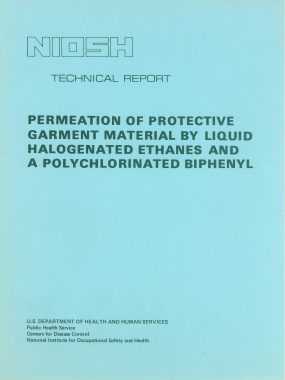Permeation of Protective Garment Material by Liquid Halogenated Ethanes and a Polychlorinated Biphenyl
January 1981
DHHS (NIOSH) Publication Number 81-110

The degree of protection of various materials against halogenated ethanes and polychlorinated biphenyls (PCBs) was investigated. Chemicals tested were 1,2-dichloroethane (107062), 1,1,1- trichloroethane (71556), n-heptane (142825), n-hexane (110543), and a PCB with characteristics of Aroclor-1254 (11097691). Protective garment materials tested were representative of materials readily available from commercial sources. Samples of protective garment materials were immersed in the chemical at about 23 degrees-C for 7 days. They were removed and weighed at 24 and 168 hours and at removal from the liquid. Weight changes were recorded. Small samples were immersed in beakers containing chemicals to determine volume changes at 1, 4, and 24 hours after immersion. Permeation cells were used for discrete sampling of solvent permeation of materials. Breakthrough time and rate were determined. Steady state weight changes were reached by polyvinyl-alcohol (9002895) and surgical rubber latex before 24 hours; neoprene rubber latex and cement dipped butyl-rubber (9010859) attained equilibrium after 24 hours, and polyethylene (9002884) had continuing weight increases through day 7. Volume change equilibrium was a function of time following immersion in the solvent. There was a noticeable change in volume between 4 and 24 hour immersions for Aroclor-1254. There was a change of about 150 percent after 24 hour immersion in 1,1,2- trichloroethane (79005) for surgical rubber latex. Breakthrough time was inversely related to equilibrium volume change for homogeneous, non bonded materials. The authors conclude that for homogeneous, non bonded materials there is an inverse relationship between the weight change of the material upon immersion in a solvent and the rate at which the solvent will break through the material.
- Page last reviewed: April 5, 2017
- Page last updated: June 16, 2017
- Content source:
- National Institute for Occupational Safety and Health Education and Information Division


 ShareCompartir
ShareCompartir